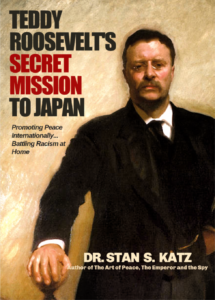
INTRODUCTION
The people we choose to honor, shape and inspire our future
Theodore Roosevelt (October 27, 1858 – January 6, 1919) a Man of and ahead of his Time.
Launching the creation of this exciting biography was the surprising acquisition of a one-of-a-kind, antique group photo which appeared to include Theodore Roosevelt, taken during a secret visit to Japan in 1909. And if it was Theodore, why had he gone there? The U.S. and Japanese flags attached to the ceiling above the eleven individuals in the photo gave the impression of a diplomatic event. Once you’ve read this biography, you’ll likely agree that Theodore, accompanied by his wife, Edith, their daughter, Alice, and their son, Kermit, along with seven other companions did take part in this most covert operation in U.S. Presidential History.
The research on the below mysterious 1909 photo revealed important new insights about Theodore Roosevelt, both the man and the creative international negotiator – This story will entertain the general public & supply historians with fascinating material for further investigation.
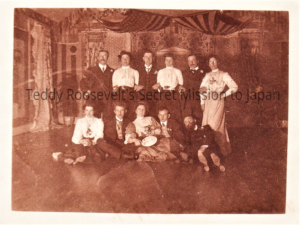
This 1909 Photo was acquired while researching for the author’s historical novel, The Emperor and the Spy, and the illustrated biographies: The Art of Peace and The Art of Diplomacy. These books highlight US Japanese relations. The novel presents a high level U.S. intelligence agent, Colonel Sidney Mashbir (1891-1973), who during the 1920’s and ’30’s formed strong alliances with Japanese leaders, together striving to maintain goodwill between their nations. The biographies spotlight the inspiring Japanese statesmen, Prince Iyesato Tokugawa (1863-1940) and Baron Eiichi Shibusawa (1840-1931), who closely engaged with eight U.S. presidents and other world leaders in the pursuit of peace, democracy, and mutually beneficial business and cultural exchange. Theodore Roosevelt, along with his presidential successor, William Howard Taft, developed a personal friendship and political alliance with Tokugawa and Shibusawa during the first decades of the 20th Century. A largely untold story.
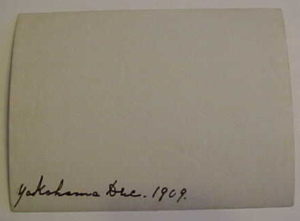
Illustrated above is the back of the mysterious group photo, with the words written in pen:
“Yokohama Dec. 1909.”
The photo measures 4.25″ x 3.25″
*It is worthy of note that in 1905, Alice Roosevelt and William Howard Taft (the then Secretary of War under T.R.), along with a large U.S. political entourage visited Japan and Asia in general. For unknown reasons, Alice required that most the photos of that journey not be shared with the general public until over a century later. When they were made available, they were utilized for an online Smithsonian Museum Exhibit titled: Alice in Asia: The 1905 Taft Mission to Asia. It appears that secrecy was required for T.R. to achieve his diplomatic goals with the Japan in 1909. And for that reason, they delayed sharing Alice’s 1905 photos with the public until the far distant future.
The below 1905 photo illustration is from Alice Roosevelt’s autobiography, Crowded Hours. It shows her and her shipmate companions – The Photo is included in the Smithsonian Museum Exhibit: Alice in Asia: The 1905 Taft Mission to Asia – It is an interesting coincidence that in the above 1909 Photo, Alice is seated cross-legged on the ground in front of her father, while in the below 1905 Photo, she is now seated cross-legged at the feet of William Howard Taft.
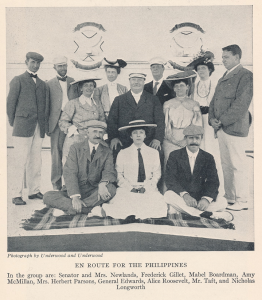
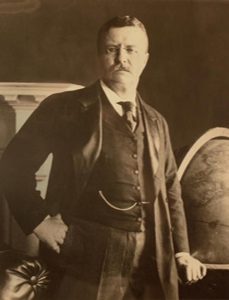
Known-photo-of-T.R.-circa-1908
Frequently referred to by his initials T.R. or Teddy Roosevelt, he is one of our most admired and even beloved presidents. Displayed below is circa 1908 Portrait photo of T.R. standing next to a World Globe. Besides being a national statesman, he wished to be recognized as a leader with a global perspective and international influence. Like most powerful presidential leaders, there were successes and controversies linked to his domestic policies and foreign engagements. These topics are explored, using hundreds of illustrations.
On a personal note: from an early age, I’ve had a deep appreciation for Theodore for various reasons, including his sheer determination to overcome his limitations as an unhealthy child, and instead live a robust, adventurous, and accomplished life.
T.R. served as the 26th president of the United States from 1901 to 1909. And before that from March to September 1901, he served under President William McKinley as the 25th vice president. Prior to those highest level national offices, T.R. also held the position as the 33rd governor of the influential State of New York from 1899 to 1900, emerging as a dominant political leader and a driving force for antitrust legislation supporting Progressive policies in the early 20th century. T.R. also wore the hat of a conservationist, naturalist, and writer. And he is respectfully depicted on Mount Rushmore, alongside George Washington, Thomas Jefferson, and Abraham Lincoln.
A great deal of new historical material was discovered that highlighted Theodore Roosevelt’s strong desire to improve the lives of Black Americans. T.R. strongly looked up to President Abraham Lincoln and his struggle to eliminate slavery. This biography highlights inspiring actions on the part of T.R. to improve Black / White race relations. Based on earlier writings and research linked to eliminating racism, the author of this biography was in 2023 nominated for the Dr. Martin Luther King Community Service Award, by the City of Oceanside, California and a Chapter of the NAACP.
T.R. looked out for the average citizen and wasn’t afraid to face off with powerful corporations in order to defend America’s natural environment. Accompanied by the naturalist, John Muir, they once embarked on a three-night camping trip exploring the most beautiful and pristine areas of Yosemite. This inspired Theodore to realize that many of America’s most beautiful areas needed protection – So he established the U.S. National Park Service which watches over this precious legacy. And during his 1909 Smithsonian Museum African Safari adventure, he used his influence to inspire the creation of the great game parks of East Africa that continue to this day.
Teddy Roosevelt’s Secret Mission to Japan
Like a Sherlock Holmes mystery, unravelling clues and finding hidden meanings, recognizing the collaborators in their 1909 mission to Japan, and those dangerous forces who stood in their way – Supporting the veracity of this extraordinary story are “Highly Top Secret” classified Japanese diplomatic letters recently unearthed from the National Archives of Japan from over a century ago. These 1908-1909 correspondences strategized how best to encourage T.R. to pay a friendly visit to Japan during his term in office or after his presidency, just as the dark storm clouds of World War One were rapidly approaching.
It appears that it was towards the conclusion of his African Safari, and before embarking on his European Peace Tour that T.R. and members of his family and their companions secretly visited Japan. The recent impressive military victory of the Japanese over the Russians in the Russo-Japanese War of 1904-1905, added importance to the US and Japan maintaining good relations. T.R.’s leadership role in bringing that conflict to an end resulted in him receiving a Nobel Peace Prize in 1906 – So US / Japan relations was a topic very close to his heart.
The amazing search capabilities of the internet assisted in the retrieval of historical newspapers/magazines and in the acquisition of long forgotten personal and official primary source materials. Included in this biography is a 1908 photo of T.R. secretly accompanied by Andrew Carnegie, attending a Memorial Ceremony for Abraham Lincoln – Carnegie wished to meet with T.R. prior to T.R.’s departure on his African Safari Adventure and European Peace Mission, which Carnegie funded.
There is also a rare 1910 photo of T.R. being met by his much younger cousin, F.D.R., upon T.R.’s return from Africa and Europe.
Another fascinating photo only recently discovered presents the then former Presidents Theodore Roosevelt and William Howard Taft in 1915, secretly attending a diplomatic banquet in N.Y.C. honoring the visit of the Japanese statesmen, Baron Shibusawa. There was a pattern of secrecy when it came to U.S. / Japan political relations.
This biography highlights T.R.’s alliances with the world’s most influential international political leaders, the wealthiest individuals, as well as European and Japanese nobility. Strategic statecraft lessons are revealed in this fascinating story, providing significant perspectives on matters that continue to influence U.S. Asian relations to this day.
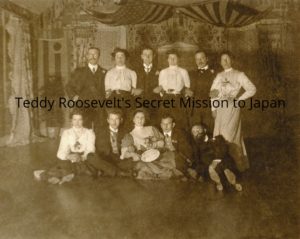
Color enhanced version of the original 1909 photo.
The book is Dedicated to these organizations
World Affairs Councils of America (WACA) – a national, non-profit, non-partisan, educational/political affairs association whose goal is international cooperation and understanding. The author is on the board of directors of the San Diego World Affairs Council, a local chapter. On a yearly basis, WACA and her many chapters across the U.S. organize exciting local and national high school competitions called Academic World Quest, where students display their knowledge of significant world events.
Rotary International promotes good-will projects in local communities and internationally. Their motto, “Service Above Self.”
Japan Society of New York City has a long history of supporting good relations between U.S. and Japan.
America-Japan Society headquartered in Tokyo, celebrated its 100th Year Anniversary in 2017. They promote peace and stability for Japan-U.S. relations, as well as for the world, encouraging educational and cultural exchange.
Shibusawa Eiichi Memorial Foundation and Museum located in Japan. Baron Shibusawa Eiichi and Prince Tokugawa Iesato were friends and allies with President Theodore Roosevelt and with other U.S. presidents in the promotion of goodwill between their nations.
National Association of Japan-America Societies (NAJAS), a private, non-profit, non-partisan organization that offers educational, cultural, and business programs about Japan and U.S./Japan relations. Located in 32 cities in the U.S., their mission to strengthen cooperation and understanding between Japan and the U.S.
*Appreciation is also given to other organizations promoting inter-racial goodwill within the U.S. and internationally.
TABLE OF CONTENTS
Chapter One 1
-Early Research to Identify the Individuals in the 1909 photo
-Overview of U.S. Japan relations mid-1800s thru early 1900s
-T.R. combats Racism against Japanese Americans
Chapter Two 31
-Economic Instability and an International Arms Race
Chapter Three 48
-Six of the Eleven Individuals in the Mystery Photo are identified
– T.R.’s exciting 1909-1910 Smithsonian African Expedition
Chapter Four 73
-Theories as to why Teddy Roosevelt might have Secretly Visited Japan in late 1909
Chapter Five 89
-Theodore Roosevelt Advances the Rights and Respect of Black Americans
Chapter Six 109
-Logistics as to how T.R. & his companions might have covertly travelled to Japan?
–The Cornelius Vanderbilt Family connection.
Chapter Seven 127
-Andrew Carnegie and the Beginnings of an International Peace Movement, Supported by T.R. & influential Japanese statesmen.
–Was History Repeating Itself? Was T.R.’s 1909 visit to Japan with his family, similar to that of former President Grant, a half-century earlier?
Chapter Eight 146
-‘Highly Classified Secrets’ at THE NATIONAL ARCHIVES OF JAPAN offers a potential key to the mysterious 1909 visit to Japan.
Chapter Nine 172
-T.R.’s fascinating 1909-1910 WORLD TOUR INCLUDES EGYPT AND EUROPE.
Chapter Ten 194
-With WORLD WAR I closing in, a strong U.S. Japan Alliance was more Important than Ever.
CLOSING REMARKS 210
ACKNOWLEDGEMENT 219
NOTES SECTION 220
Additional Research Resources 265
Index 267
Praise for Author’s Prior Books
The Emperor and the Spy historical novel
‘’I have learned a lot about Colonel Mashbir and his real friendship with Prince Tokugawa which was a pleasant surprise for me. Your stories about Japanese-American Military Intelligence Service have also done a great justice to so many unsung heroes.” Kazuo Kodama, former Japanese Ambassador to the United Nations
“I realize how difficult it is to weave fact and fiction but you did a masterful job. I have often wondered about the closing of WW II and how Japan got its new system of governance.” J. L. Ruthenberg, Lieutenant Colonel, USMC, Retired
“A fascinating story . . . a fine book,”
Lisa Wolff, past Managing Editor of Simon & Shuster
BARNES & NOBLE chose this novel to honor Veterans Day Weekend with a Book signing at their Oceanside, California Store.
“Novelist brings spy out of the shadows. Looking forward to the movie.”
Pam Kragen, SAN DIEGO UNION TRIBUNE
“The Emperor and the Spy…I couldn’t put it down.”
Hilliard Harper, Retired Naval Reserve Commander and former Writer for the Los Angeles Times
“My mother is a history expert. She taught history to high schoolers. She read your book in a day over the weekend and is now rereading it. These are her comments: It’s a fun read, page turner, shows tremendous research, historical novels don’t get better than that, intelligently written book, informative, conversations enlightening, she learned a lot…In sum, she said this is an outstanding book. Congratulations!”
Dave Edick Jr., President of San Diego World Affairs Council & President of San Diego International Sister Cities Association
“The book is fast-paced yet thoroughly researched. I compare the depth and factual detail of Katz’s writing with those of Wilbur Smith and Dick Francis. You’ll appreciate the weaving of concurrent events, and the nuances only an expert in the field can convey. Like Frederick Forsyth’s books, the international intrigue with imminent national security threats keep one in suspense . . . Katz’s narrative subtly demonstrates the pivot points around which the arc of history may have been so very different… It’s deliciously epic.”
Rita Lim Wilby PhD., Rotarian and Chairman of Programming at San Diego World Affairs Council
“Thank you for having interest in Japanese History. Looking forward to your new book! [The biography of Prince Tokugawa]
Kenko Sone Director of Global Communications for Shinzō Abe Prime Minister of Japan
The Art of Peace & The Art of Diplomacy illustrated biographies
“The importance of preventing war is rarely given recognition through literature and in accounts of history. It can be every bit as exciting as glorified accounts of war and certainly a better approach.” Professor Claire Langham, former President of the East-West Center of Southern California
“We look forward to adding The Art of Peace to the School’s library collection. Your goal to reach high school and college students with this information is an ambitious – but important – goal. Best wishes with your project.”
Suzette Heiman, Director of Planning and Communications Missouri School of Journalism at University of Missouri
“We appreciate your kindness and all the work you have done to promote understanding of Shibusawa Eiichi and US-Japan relations as a whole. I wish you all the best in your current and future endeavors. With gratitude,” Toru Shigehara: Head Librarian/Information Resources Center, Shibusawa Eiichi Memorial Foundation and Museum located in Japan
Include your Contact info on TheEmperorAndTheSpy.com website to be notified when the Theodore Roosevelt Biography is published.
You’re also invited to Like the Facebook Author Page: https://www.facebook.com/TheEmperorAndTheSpy/
Leave a Reply